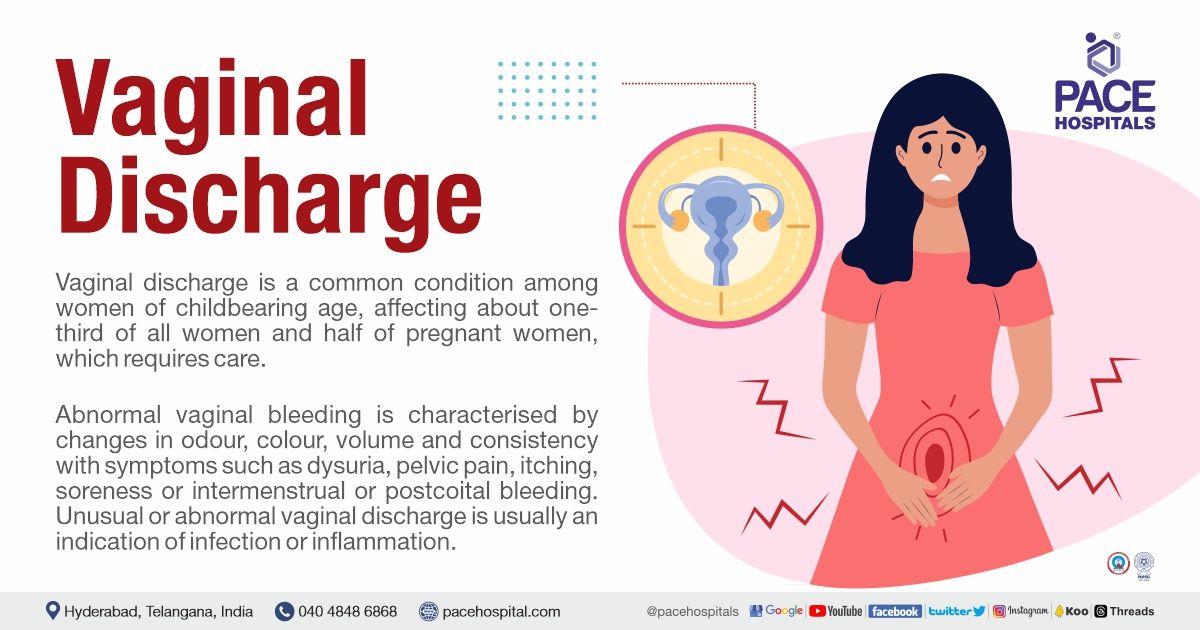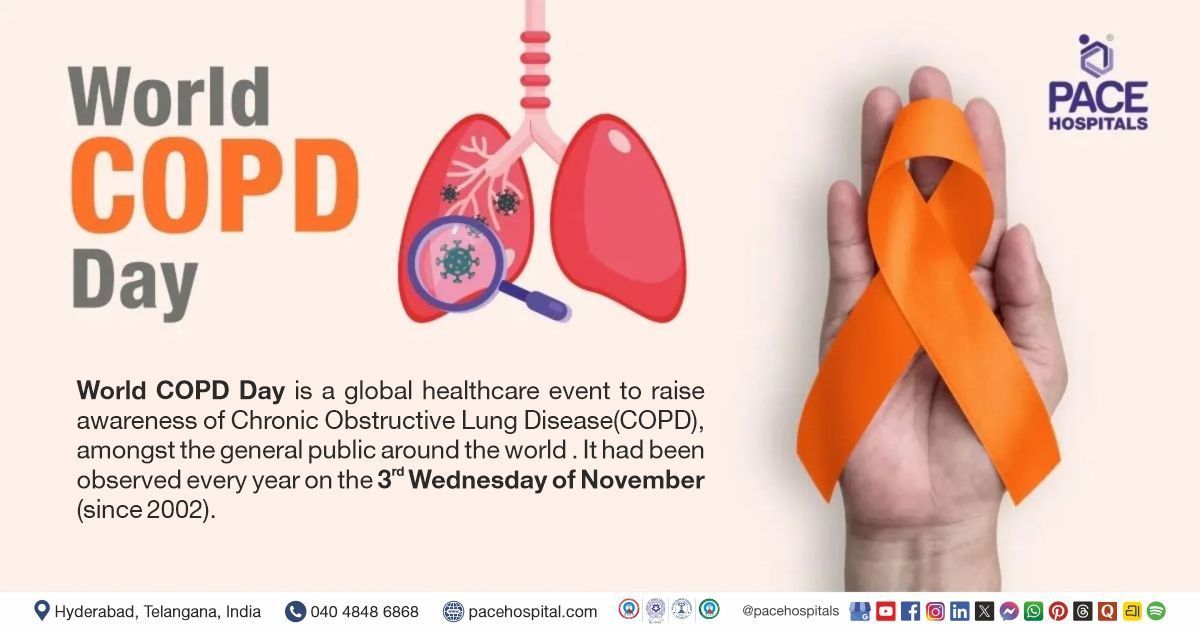Vaginal Discharge - Types, Causes, Symptoms, Treatment, Prevention
PACE Hospitals
Vaginal discharge meaning
Vaginal discharge is a mixture of fluid comprising bacteria, mucus (liquid) and dead cells secreted by the cervix and vagina to protect the vagina by maintaining the PH, lubricating it, moistening, and keeping it clean.
It is a natural secretion of the female reproductive system, The vagina starts making discharge during the puberty. It is a way for the body to respond to any hormones that are secreted in the body. Thus, it is also a mechanism for protecting the vagina from various diseases or infections.
The amount and consistency of the discharge may vary from one woman to another. Vaginal discharge can change (amount, colour and consistency) during the woman's menstrual cycle and over the years. It may become more apparent at specific times, such as during pregnancy, during sexual arousal, ovulation, luteal phase, puberty, and with estrogen-based therapies such as combined hormonal contraception and hormone-replacement therapies.
Prevalence of Vaginal Discharge (VD)
Vaginal discharge is a common condition among women of childbearing age, affecting about one-third of all women and half of pregnant women, which requires care.
About 30% of women in India experience vaginal discharge, a common health complaint among women, especially those of reproductive age. Vaginal discharge is a natural method for the body to maintain vaginal health.
Vaginal Discharge During Pregnancy
Vaginal discharge during pregnancy is completely normal. This helps prevent any infections that travel from the vagina to the uterus. Normal vaginal discharge during pregnancy comes in more significant amounts.
Types of vaginal discharge during pregnancy
These are the following types that a pregnant woman experiences include Leucorrhoea, mucus plug, bloody show, watery discharge, increased mucus.
- Vaginal discharge during early pregnancy (vaginal discharge early pregnancy) is clear, thin, or milky white and smells only mildly.
- Most pregnant women notice increased (excessive) vaginal discharge in early pregnancy (first trimester) and throughout the pregnancy due to hormonal fluctuations (increased estrogen) and increased blood flow to the pelvic area. This is called leucorrhoea.
- Women experience pinkish mucus or brownish vaginal discharge may occur at the second and third trimester. It indicates that blood is leaving the body with normal discharge in small amounts.
- During incubation (pregnancy), a mucus plug seals the cervix's opening to prevent the infections from entering the womb.
- When the cervix starts dilating in preparation for labour, the plug will come out. This is called a "show" and appears watery, sticky or jelly-like. It might contain blood or appear brown or pink.
- At the end of pregnancy, the female body produces more vaginal discharge as sticky, jelly-like pink mucus streaks.
Smelly vaginal discharge during pregnancy may occur due to yeast infection, spicy foods and scented soaps. Other causes include vaginitis, bacterial vaginosis, dehydration, etc. Pregnant women can have a higher chance of developing vaginal thrush or bacterial vaginosis (causing unusual vaginal discharge).
Abnormal vaginal discharge during pregnancy may look like cottage cheese or froth, green, yellow, grey or brown, have a foul smell and is associated with pain or irritation around the vagina.It indicates the abnormality.
Normal Vaginal Discharge
Normal vaginal discharge colour is white, creamy or clear, with sometimes a slight yellow tint, and it has no noticeable odour (odourless) or irritation.
- Vaginal discharge during menstruation: Usually, healthy vaginal discharge changes in odour and consistency during the menstrual cycle. It is bloody or dark brown from the first to the fifth day of menstruation. From the sixth to the 14th day, it becomes clearer and thinner in consistency.
- Vaginal discharge during ovulation: Usually, during ovulation or nearing the ovulation, colour of normal vaginal discharge becomes egg-white and thicker or slippery in consistency. This is an indication that a woman is ovulating.
- Vaginal discharge before period: After ovulation, the amount of vaginal discharge usually decreases and becomes thicker in consistency. This happens between days 25 to 28, just before the next menstrual cycle. During this time, the discharge may appear a little whitish and have a lumpy or clumpy texture. A vaginal discharge is normal until and unless associated with any itching, pain, or foul smell.
- Vaginal discharge before missed period can differ based on several factors and may not always indicate pregnancy.
- Female vaginal discharge (at Premenopausal stage) usually has around 2 to 5 mL (one-half to one teaspoon) of white or clear, thick, mucus-like and primarily odourless vaginal discharge daily.
- After menopause, estrogen levels will decrease, usually reducing the amount of normal discharge.
Abnormal Vaginal Discharge
The female vagina contains a lot of good bacteria called lactobacilli that help clean and maintain the vaginal PH (slightly acidic), keeping it healthy. If the balance of good bacteria is disturbed and there is an overgrowth of yeasts or harmful bacteria, it may result in abnormal vaginal discharge. A disturbance in the balance of healthy bacteria can affect the vagina discharge and lead to changes in it.
Abnormal vaginal bleeding is characterised by changes in odour, colour, volume and consistency with symptoms such as dysuria, pelvic pain, itching, soreness or intermenstrual or post-coital bleeding. Unusual or abnormal vaginal discharge is usually an indication of infection or inflammation.
Vaginal Discharge Types
All types of vaginal discharge that present in females based on multiple factors. However, based on the colour, the following are the different types of vaginal discharge:
- White vaginal discharge
- Brown vaginal discharge
- Pink vaginal discharge
- Yellow vaginal discharge
- Green vaginal discharge
- Gray vaginal discharge
- Watery vaginal discharge
Types of vaginal discharge and what they mean
- White vaginal discharge: White or clear discharge usually indicates the normal vaginal discharge. It is common, particularly at the start or end of the menstrual cycle. It will be sticky and thick with no noticeable smell. It helps balance the vaginal health, and if it is thick, clumpy and associated with pain or itching (white vaginal discharge and itching), it could indicate infection or other medical issues. Usually, it indicates the cleaning of the vagina itself to prevent infection.
- Brown vaginal discharge: Brown or red discharge is commonly seen during menstrual periods. If one has a red-brown tinged discharge, and it is not related to menstruation, it may indicate a problem. Colours might change from cherry red at the beginning of the menstrual period to rusty brown.
- Pink vaginal discharge: Having a pink discharge (a reddish, pink or brown without smell) at the beginning days before the period starts or after it ends in a woman of childbearing age is considered normal.
- Yellow vaginal discharge: Very light-yellow colour discharge is expected. If it is yellow-green appearance is there, then it indicates a sign of infection.
- Green vaginal discharge: It is not normal (abnormal) and needs medical attention. If the vaginal discharge is thick, clumpy, or foul odour, it may indicate infection or other medical conditions.
- Gray vaginal discharge: Gray vaginal discharge is not normal or healthy, and it can be a sign of infections.
- Watery vaginal discharge: It helps to clean the vagina and is free from infections. Healthy bacteria in the vagina help make acidic secretions, which help fight against harmful bacteria and clear out dead cells.
Vaginal discharge Causes
There are numerous elements that cause vaginal discharge; based on the causative factor, the colour of the discharge exists. The common causes of vaginal discharge include the following:
Causes of white vaginal discharge
Vaginal white discharge causes include:
- Female healthy vaginal secretions
- Bacterial vaginosis
- Yeast infection
- Sexually transmitted Infections
- Hormonal fluctuations
Curdy white vaginal discharge causes
Curd like vaginal discharge (white clumpy) causes include:
- Yeast infection (main cause)
- Sexually transmitted infections (STI’s)
- Bacterial vaginosis
- Hormonal changes
Causes of thick vaginal discharge
Thick vaginal discharge causes include:
- Sexual arousal
- Ovulation
- Hormonal imbalances
- Vaginitis
- Bacterial vaginosis
- Trichomoniasis
Causes of watery vaginal discharge
Watery vaginal discharge causes include:
- Hormonal imbalances
- Sexual arousal
- Pregnancy
- Exercise
- Cervical surgery
- Ovulation
- Fertility medicines
Causes of clear vaginal discharge
Clear vaginal discharge causes include:
- Healthy
- Hormonal changes
- Pregnancy
- Ovulation
Causes of abnormal vaginal discharge
Abnormal vaginal discharge causes include:
- Yeast infection
- Trichomoniasis
- Bacterial vaginosis
- Sexually transmitted infections
- Cervical cancer
- Diabetes
- PID (Pelvic inflammatory disease)
- Douching
- Antibiotic or steroid use
- Vaginal atrophy (Drying and thinning of vaginal walls during menopause)
- Vaginitis
Causes of excessive vaginal discharge
Excessive vaginal discharge causes include:
- Sexual arousal
- Pregnancy
- Infections
- Infections
Causes of pink vaginal discharge
Pink vaginal discharge causes include:
- Around ovulation
- During implantation
- In-situ techniques
Causes of brown vaginal discharge
Brown vaginal discharge causes include:
- Cervical irritation
- Pre-cancerous conditions
- Endometrial condition
- Post-menopausal bleeding
- Inter-menstrual spotting
Vaginal Discharge Symptoms
A vaginal discharge is normal until and unless associated with any itching, pain, or foul smell. Abnormal discharge has the following symptoms:
- Yeast infection: Curdy white or chunky odourless vaginal discharge with little pain or irritation, swelling around vagina.
- Bacterial vaginosis: Greyish, whitish foul smell vaginal discharge with pain or irritation around vagina and painful sex.
- Trichomoniasis: Yellowish or greenish foul smell vaginal discharge with inflammation around vagina.
- Herpes: Some blisters or vesicles with ulcers will be painful, whereas in syphilis the blisters are painless.
Other common signs and symptoms of vaginal discharge include:
- Pain in lower abdomen
- A change in discharge
- Bad odour more than a day
- Bleeding between periods
- Urinary Incontinence
- Blood-tinged vaginal discharge
- Painful urination
- Vaginal dryness
- Urinary tract infections
Warning signs of vaginal discharge:
- Increased temperature
- Pelvic pain
- Stool in the vaginal discharge
- Bloody discharge after menopause
Vaginal Discharge Diagnosis
Gynaecologists perform gynaecological and obstetrical examinations to thoroughly examine and assess the reproductive health of females, that play a crucial role in maintaining overall female health and wellness. The gynaecologist considers the following before prescribing the appropriate diagnostic tests.
- Patient signs and symptoms
- Patient’s age, family history and general health
- Medical history (hypertension, high blood glucose levels, high cholesterol) and medication history that includes herbal and over the counter medications.
- The results of previous medical tests
- Usage of tobacco and consumption of alcohol
Screening
Females should have a reproductive health examination every year starting at the age of 13-18. Usually, a pelvic evaluation is not done before age 21 unless there is an issue such as pelvic pain, irregular periods or abnormal vaginal discharge. Gynaecologists test sexually active woman for sexually transmitted infections (STI's). During examination, the gynaecologists will have a clear view to the external genitalia and look for signs of herpes vesicles, blisters, and irritation. The vaginal walls will be checked for redness (erythema) and abnormal discharge. Using a tiny sterile swab, look for pus in the endocervix (innermost part of the cervix).
- Physical examination
- Pelvic examination
- Blood tests
- Urine tests
- Pelvic ultrasound
- PAP test
- HPV test
- Swab test
Vaginal Discharge Treatment
Treatment depends on the type of infection or other medical underlying cause. Most vaginal infections are not dangerous and can be cured with prescribed medicine. However, if untreated, symptoms may worsen and cause long-term complications.
- Usually, treatment of yeast infection includes antifungal medications (anti-mycotics).
- Typically, the symptoms of fungal vaginal discharge disappear after a short treatment with topical medications applied directly to the vagina.
- However, in some cases, it may be a good idea to take oral medication in the form of tablets or to undergo a more long-term treatment plan.
- Sexually transmitted diseases and bacterial vaginosis can be treated by using antibiotics.
- It is recommended to check for health (regular screening) at least once a year in sexually active women.
- For sexually transmitted infections (STIs) such as gonorrhoea, chlamydia or trichomonas, the patient partner (sexual partner) has to be needed to treat.
- For other infections, such as bacterial vaginosis or yeast, the sexual partner does not need any evaluation and treatment.
- White vaginal discharge treatment and smelly vaginal discharge treatment involves the identifying the underlying cause.
Vaginal Discharge After Hysterectomy
Hysterectomy is the surgical method of removing the uterus. The patient may experience light spotting for 2 to 4 weeks after the hysterectomy procedure. It may be pink, red, or brownish without any foul odour. It typically indicates the healing. After some days, it will become lighter in colour and consistency. If the ovaries are removed, the patient can experience changes in vaginal dryness or lubrication because of hormonal fluctuations.
Why Choose PACE Hospitals?
Expert Super Specialist Doctors
Advanced Diagnostics & Treatment
Affordable & Transparent Care
24x7 Emergency & ICU Support
Prevention of Vaginal Discharge
It is not possible to prevent or avoid the vaginal discharge. It is essential to keep the vagina clean, dry and healthy. Internally, the vagina cleans itself, so it is unnecessary to clean inside with vaginal douche. Do not wash inside the vagina.
- Avoid douching: Using vaginal wash a lot which might alter PH and finally end up having more vaginal discharge, making more prone to more of these diseases.
- Don't use hard soaps or perfumed sprays to reduce the smell, as they cause irritation, dryness or soreness. Instead of using hard soaps, use plain water to wash the skin around the vagina.
- Using panty liners can help with excessive or heavy vaginal discharge.
- Avoid tight-fitting clothes as they do not let the air move, wear loose, cotton-lined underpants, which help absorb moisture.
- Avoid multiple sexual partners to stay away from the sexually transmitted infections.
- Including a probiotic in food such as buttermilk curd, eating more fresh fruits and vegetables, and drinking plenty of water.
- Get a regular screening.
- Partner has to be tested for sexually transmitted diseases to prevent getting infected.
Frequently Asked Questions (FAQs) on Vaginal Discharge
Share on
Request an appointment
Fill in the appointment form or call us instantly to book a confirmed appointment with our super specialist at 04048486868











